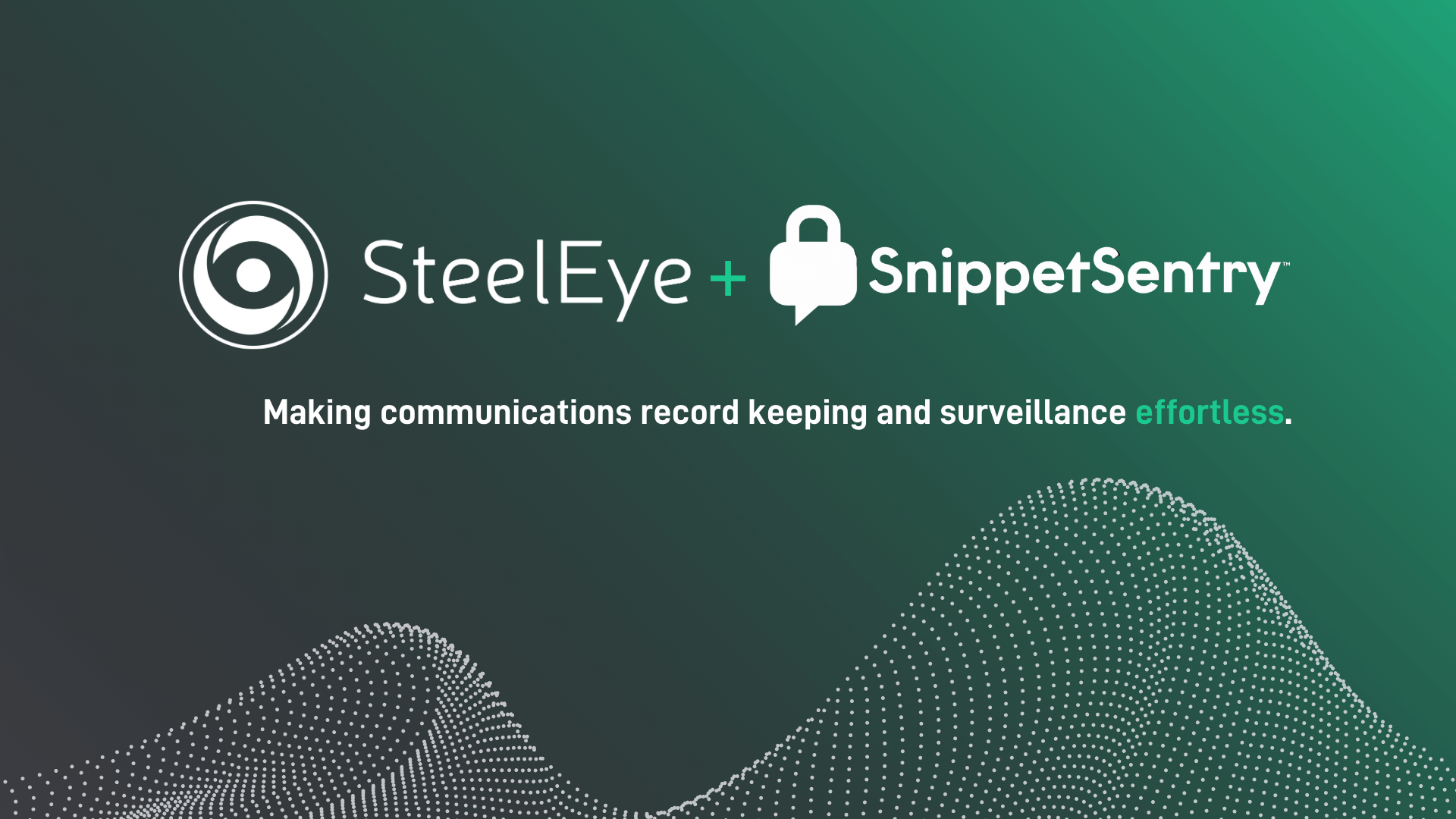A SteelEye summary of the key highlights from Regs & Eggs 2024 at the House of Commons
As AI continues to transform industries, its impact on areas like communications surveillance is highly promising. At Regs & Eggs 2024, industry experts from Baird, PwC, and TD Securities discussed the application of AI in financial services and how firms can effectively navigate AI in crucial areas like communications surveillance.
Overall, there is a positive outlook for the role of AI in financial services. In particular, there is a view that AI and large language models (LLMs) can drive efficiencies, increase productivity, and enhance risk detection in communications surveillance. However, to fully realize these benefits, several key considerations must be carefully addressed.
Here’s a look at the insights and strategies discussed at SteelEye’s 2024 Regs & Eggs event at the House of Commons on the 20th of June.
A positive outlook for AI in communications surveillance
One of the most exciting aspects of AI and LLMs is their ability to optimize processes in communications surveillance. For example, many financial firms today simply cannot review all call activity and work through the entire alert queue. With AI-powered surveillance, firms can move from monitoring a proportion of communications activity to monitoring 100% of it. Consequently, many people believe the technology will not only help firms streamline the review process and reduce false positives but also identify more bad actors.
This can allow firms to reduce administrative tasks and free up resources for higher-level work, resulting in improved job satisfaction and reduced compliance fatigue.

The use of AI and LLMs can also enhance risk detection accuracy in communications surveillance and help detect not only financial risks such as market abuse but also non-financial risks like culture and conduct issues.
Unleashing the Potential of Voice Surveillance
Voice surveillance stands out as a particularly promising application of AI. AI's ability to understand and alert on multiple languages, even during language switching, is a game-changer. AI models equipped with LLMs can seamlessly handle these transitions, ensuring that no details of the conversations are missed due to language changes.

Moreover, LLMs excel at processing different contexts of language use. This is particularly powerful when considering voice. People typically communicate differently in spoken language compared to written text, often using colloquialisms, slang, and informal phrases. Then there are the complexities of accents. Effective AI systems can distinguish and understand these nuances, providing a more accurate and comprehensive analysis of communications. This contextual intelligence is vital for identifying risks that might be overlooked in traditional surveillance methods but is, of course, dependent on accurate and precise voice transcription.
Voice transcription
Voice transcription technology has also benefitted from the evolution of AI, where systems are now better able to understand voice and convert it to text. This is foundational to effective voice surveillance.
However, while most vendors tout high precision-recall and accuracy rates, it is essential that firms verify these claims through testing. A recommended approach is to conduct manual reviews of vendor transcriptions. This involves taking a sample of calls, running them through the vendor's software, and then comparing the AI-supported transcripts with those produced manually by analysts.

Challenges and Key Considerations
 Managing the Risks of AI in Surveillance
Managing the Risks of AI in Surveillance
While integrating AI into surveillance introduces some new risks, they can be well managed with a robust governance and control framework. This sentiment echoes the FCA's stance at SteelEye’s Regs & Eggs event in 2023.
When evaluating these risks, it is crucial to balance them against the efficiency gains AI offers, the increased percentage of conversations that can be monitored, and the enhancements in risk detection. Many believe that not utilizing AI to unlock these benefits poses a greater downside than the risks it introduces.
Understanding AI's functionality is vital—it's not about replacing humans but enhancing their efficiency. Continuous human oversight throughout is essential, ensuring that AI complements human judgment rather than replacing it.

Build vs. Buy
The build vs. buy debate has been ongoing for ages and is something financial firms need to consider when they approach AI technology.
Although regulators remain technology-agnostic, they often favor third-party vendor technology due to its rigorous stress-testing and validation across multiple firms, which makes it inherently robust and secure. Market validation is crucial in surveillance, benefiting vendors as they continuously refine their solutions in collaboration with clients.
Financial firms seem to echo this sentiment, finding third-party compliance technologies reassuring as they are used by a variety of clients and are trusted by regulators.
But while the market seems to have really leaned into the buy side of this argument, firms must remember that while technology can be outsourced, responsibility cannot. The buck ultimately stops with the regulated firm.

Explainability
Incorporating AI into communications surveillance requires a deep understanding of the technology. Firms must fully comprehend and be able to articulate how these systems work, and this should be documented within the firm's operating model.
Avoiding "black box" solutions – where the decision-making process of the AI is not transparent – is critical. Firms need to know precisely how their AI models reach conclusions, especially when these conclusions impact compliance and risk management. Understanding the mechanisms behind AI decision-making enables firms to troubleshoot issues, ensure compliance, and maintain control over the technology. Additionally, this explainability is crucial for firms when subjected to regulatory examinations. Regulators will often look beyond “what” technology is being used, and instead focus on “how” a firm is leveraging the technology.
As a result, vendor transparency is crucial. Vendors must provide clear, detailed explanations of their technologies, allowing firms to grasp the inner workings of AI models. This level of transparency builds trust and facilitates effective implementation. Most reputable vendors recognize the importance of this and strive to provide comprehensive insights into their systems.

Verifying AI Outputs
When evaluating AI technologies for communications surveillance, firms should conduct rigorous testing using their own data, not just vendor-supplied data, to ensure the models perform as expected.
This should not be viewed as a one-off process. Once an AI model has been deployed, firms need to establish regular processes for model verification, checking that systems continue to deliver accurate and reliable results.
Firms should think of it as establishing guardrails for the technology to prevent data drift, ensuring the validity and integrity of data and model outputs.

Data Privacy and GDPR
Different privacy laws across countries necessitate tailored monitoring policies. There is no one-size-fits-all approach. For example, countries such as Germany have strict limits on employee surveillance.
It is also important that compliance teams consider who should and shouldn’t be covered when it comes to monitoring. In most instances, all employees within a regulated firm will be covered by surveillance. However, there are exceptions and legal restrictions that need to be considered in special cases, such as summer interns who are minors. Firms should be transparent about surveillance practices and technology usage with employees, customers, and partners, updating privacy policies as needed.
Education is also a critical element. Continuous training on culture and conduct is essential, especially for new hires, to ensure they understand surveillance practices and expected conduct.
Lessons learned from other parts of financial services
Examining the current utilization of AI in the financial sector reveals several noteworthy applications that can be transferred to compliance.
-
Some banks leverage AI and LLMs to enhance productivity in fraud call centers. AI-powered transcription technologies are used to summarize calls, saving a significant amount of time per call that agent would otherwise spend taking and uploading notes. It also improves the accuracy of call notes, and allows agents to concentrate on more complex tasks.
-
Other firms employ these technologies to enhance customer service by streamlining the search of retrieval of information, enabling more tailored information delivery to customers. This results in faster response times, improved customer satisfaction, and higher job satisfaction by employees.
-
In fraud detection, AI models are used to analyze behavioral biometric indicators to improve the detection of fraudulent payments.

These use cases are directly applicable to communications surveillance. AI can help summarize, analyze, and rank communications based on key risk factors, freeing up time for surveillance analysts to focus on more meaningful tasks. Additionally, AI models can incorporate contextual data alongside traditional lexicon and risk-based approaches, including biometrics, to strengthen risk detection and reduce false positives.
The Future of Communications Surveillance
-
The Journey Toward AI Integration
While many firms are just beginning to explore AI's possibilities within communications surveillance, the consensus is clear: AI is the future. In fact, according to SteelEye’s 2024 Compliance Health Check Survey, 58% of firms have already implemented some form of AI to improve compliance processes.
Securing budgets in 2024 to invest in AI technologies for communications surveillance will be important, with a two-year horizon for full utilization. This preparation phase involves building the necessary infrastructure and understanding AI's capabilities to leverage its full potential.
-
Evolution of Voice Surveillance
Over the next year, we are likely to see much firmer regulatory guidance around voice surveillance, which will result in a substantial evolution in this space.
-
Holistic Surveillance
In the longer term, we will see a shift towards integrated surveillance, where trades and communications are merged together in a holistic platform, with AI making upfront suggestions based on connected data. We will also see an evolution of targeted surveillance which leverages behavioral data to create a more targeted picture of risk.

The insights shared at Regs & Eggs 2024 underscore the transformative potential of AI in communications surveillance. As AI technologies, particularly LLMs, continue to evolve, they promise to enhance the efficiency and accuracy of surveillance processes.
However, integrating AI into surveillance systems is not without challenges. Firms must navigate issues related to data privacy, model explainability, and continuous validation to ensure that AI systems function reliably and transparently. The importance of maintaining human oversight and understanding the mechanisms behind AI decision-making cannot be overstated.
As we look to the future, the consensus is clear: AI will play a crucial role in shaping the next generation of communications surveillance. Firms that invest in AI infrastructure and capabilities today will be better positioned to leverage its full potential in the coming years. With continuous advancements and evolving regulatory guidance, the journey toward comprehensive, AI-driven surveillance promises to be both challenging and rewarding.

During the Regs & Eggs session, we expanded our focus to examine the macroeconomic changes impacting the United Kingdom. Lord Daniel Finkelstein provided a politically neutral analysis of the upcoming election, predicting a likely Labour victory due to their lead in both leadership and economy contests.
Lord Finkelstein emphasized the significant financial constraints any new government would face. With government spending at an all-time high and substantial debt levels, Finkelstein suggested that the focus would shift to non-financial policy changes.
Labour has already indicated they will not increase national insurance or taxes, aside from a VAT on private schooling. Instead, we might see initiatives like increasing the national living wage, enhancing maternity and paternity provisions, and promoting workplace equality—policies that benefit people without direct financial costs.
In the financial services sector, Finkelstein stated we could potentially see stricter regulations under a Labour government, aimed at achieving better social outcomes.
Regarding AI, Finkelstein noted that most politicians do not fully understand its implications, which is why it hasn't featured prominently in this election. However, he predicted that AI-related issues, particularly fraud, would dominate political conversations over the next five years.


Communications Surveillance by SteelEye, powered by our AI-driven Compliance Copilot
SteelEye's Communications Surveillance solution, powered by our Compliance CoPilot, enables compliance teams to master eComms and vComms compliance.
-
The platform supports any communication channel including voice, chat, email, meetings, and social messaging.
-
SteelEye provides language detection, transcription, translation, and surveillance in 40+ languages, including risk detection for language switching across written and spoken communications.
-
Our AI-assistant reduces the communication surveillance alert review process by 75% through intelligent alert scoring, triaging, and workflow automation.
-
SteelEye embeds the ability to easily tailor alerting criteria to meet specific needs.
-
SteelEye's data controls and governance framework is designed to ensure the integrity and completeness of data. The platform provides a comprehensive audit of data receipt and processing, with proactive data governance alerts.
Discover the Power of SteelEye's Advanced Solution, Trusted by Financial Institutions Across the Globe
Discover Communications Surveillance by SteelEye















